Abstract
The paper investigates the phenomena of adhesion in binder-aggregate systems produced to reflect warm-mix asphalt with water-foamed bitumen. The investigated materials included limestone and quartzite aggregates and a total of four asphalt binders: 50/70 and 45/80–55 bituminous binders obtained from two sources. The adhesive bonding between the asphalt binders and aggregates was evaluated in boiling water stripping tests, which results were quantified using digital image analysis. The bituminous binders were additionally tested for their dynamic viscosities, and their chemical composition was probed using FTIR spectroscopy. The tests were carried out using traditional liquid and foamed bituminous binders on samples prepared at temperatures characteristic of hot-mix asphalt and warm-mix asphalt production (20 °C decrease). The use of foamed binders yielded higher values of residual asphalt binder coverage of the aggregates. Limestone aggregates provided superior adhesion, with the lowest result amounting to approximately 88%, while with quartzite aggregates, the results ranged from approximately 40% to 87%. The refinery from which the asphalt binders were sourced had a significant influence on the results; however, the additional rheological and chemical analyses were insufficient to explain those differences. It was concluded that the process of asphalt binder foaming, per se, may have a beneficial impact on the resistance of the asphalt binder-aggregate system to the action of water.
1. Introduction
In recent years, new materials and techniques have been introduced in the road construction industry, permitting a shift toward more energy-efficient and sustainable transport infrastructure. Incentives toward these goals are provided by government strategies toward emission reductions such as ‘The Roadmap to a Resource Efficient Europe’ put forward by the European Commission (EU). These new developments include the introduction of reclaimed materials and industrial by-products [1,2,3,4,5,6,7,8,9], reinforcement [10,11,12,13], use of decreased processing temperatures [14,15,16], and novel approaches to mix design [17,18]. The warm-mix technologies were first introduced in the 1990s, and over the years, they have proven to mostly perform on par with comparable hot mixes [14,19,20]. Nevertheless, some concerns regarding the early service performance of these mixtures remain [21].
Warm-mix technologies allow for significant reductions in emissions and energy consumption associated with road construction [14]. Typically, mixtures recognized as warm-mix asphalt (WMA) are produced at temperatures 20 to 30 °C lower than equivalent hot mixtures. Different methods are used to obtain the required workability and compactability of those mixtures: asphalt binder additives [16,22], asphalt binder foaming [23,24], asphalt mix additives [25,26,27,28], binder fluxing [29], and combinations of the mentioned measures [23,30,31,32].
The use of mechanical water foaming permits the production of warm-mix asphalts without any other additives, while other techniques usually have some built-in antistripping measures. This fact provides a possibility for investigating the moisture resistance of such mixtures without the confounding effects of antistripping agents. It should be noted, though, that antistripping agents are usually used in water-foamed mixtures as an obligatory measure for increasing the pavement durability, just as in hot-mix asphalt. Many studies have been recently published regarding the effects of foaming on the properties of bituminous binders. The majority of the works focus on the functional properties of the foamed binders, mostly showing no significant detrimental effects of the foaming process; however, decreased aging of the binders is often raised as a potential problem for the short-term high-temperature performance of these mixtures [33,34,35,36,37,38,39,40,41,42]. A number of studies have been published on the resistance to moisture damage of warm-mix-asphalt produced using mechanical water foaming, showing that these mixtures may be more susceptible to the action of water [43,44,45,46]. In some studies [44], it was also shown that plant-produced foamed warm-mix asphalt exhibits similar moisture susceptibility to hot-mix asphalt, as opposed to laboratory-produced warm mixes. It was also demonstrated that the amount of aging may have significant effects on the moisture resistance of warm-mix asphalts, proving that adequate laboratory aging [47] or summer aging before the winter period [48] may be sufficient to improve this characteristic.
Although the moisture susceptibility tests involving compacted asphalt mix specimens tend to represent the performance of the final mixture quite well, their results may be confounded by additional factors such as degree of compaction, mixture gradation, mixture composition, or even the conditioning protocol (e.g., MIST vs. freeze-thaw as reported in the work of [44]). Such factors are excluded in model studies, such as the binder-aggregate affinity tests using different methods [49]. These methods, in general, can be separated into three groups: rolling bottle methods (typically carried out at room temperature), static methods (at room or elevated temperatures), and boiling water stripping methods. All mentioned tests exhibit disadvantages, e.g., strong mechanical action in the rolling bottle method, long testing time, and weak differentiation of static tests, while the boiling water methods are troublesome and may be inaccurate due to the use of calibration curves and chemical reagents [50]. A number of authors have used digital image analysis for assessing the results of these tests with great accuracy and confidence [51,52,53,54,55,56,57].
Based on the presented literature in the subject area, a study was conducted to investigate the effects of mechanical water foaming on the stripping performance of different aggregate-bitumen systems in model studies, using the boiling water stripping method and digital image analysis method for evaluating the results. The boiling water stripping method was chosen as being among the least influenced by the mechanical properties of the aggregate (in opposition to the rolling bottle method) and due to its short duration, which was important given the extensive testing program. Additionally, asphalt binder tests were conducted to explore the possible sources of the variance in the results of the stripping tests. Tests for evaluating dynamic viscosity were conducted in relation to its role in the surface energy theory of aggregate-bitumen adhesion and its mechanical resistance to flow during the boiling tests, while the FTIR analyses were also conducted to evaluate the presence of carboxylic and sulfoxide compounds contributing to the moisture susceptibility of the binders [58,59,60].
2. Materials and Methods
2.1. Design of Experiment
The study involved boiling water stripping tests and basic asphalt binder tests to evaluate the impact of bitumen foaming and the decreased mixing temperatures on the aggregate-bitumen bonding. A full factorial 25 experimental design with three replicates (three boiling tests) was conducted. The study totaled 32 different experiments and required 96 boiling water stripping tests to be performed. The factors included in the design were as follows:
- Type of the asphalt binder:
- ○
- PGB—50/70 paving-grade bitumen
- ○
- PMB—45/80–55 polymer-modified bitumen
- Source of the asphalt binder:
- ○
- A—source A
- ○
- B—source B
- Form of the binder while it was added to the aggregates:
- ○
- N—non-foamed
- ○
- F—foamed
- Temperature at which the aggregates were coated:
- ○
- H—hot, corresponding to hot-mix asphalt mixing temperatures:
- ▪
- 150 °C when the 50/70 PGB binders were used
- ▪
- 165 °C when the 45/80–55 PMB binder were used
- ○
- W—warm, corresponding to warm-mix asphalt mixing temperatures:
- ▪
- 130 °C when the 50/70 PGB binder were used
- ▪
- 145 °C when the 45/80–55 PMB binder were used
- Type of the aggregate used:
- ○
- L—limestone
- ○
- Q—quartzite
The experimental plan has been shown in the form of a matrix in Table 1.

Table 1.
Characterization of the paving-grade and polymer-modified bitumen used in the study.
The asphalt binders were selected based on their broad use in asphalt mixtures for surface courses subjected to all kinds of traffic. The asphalt binders were subjected to dynamic viscosity testing and chemical analysis using infrared spectroscopy.
The mixing temperatures corresponding to the production technology of hot-mix asphalt were established based on EN 12697-35 [61] standard in case of the paving-grade bitumen and based on the manufacturer’s recommendations in the case of the polymer-modified binders. The temperatures corresponding to warm-mix asphalt technology were set 20 °C lower than the established hot-mix temperatures. Asphalt binder-aggregate adhesion was measured indirectly using boiling water stripping tests and evaluated by digital image analysis.
2.2. Materials
The investigation used a total of four asphalt binders used widely in surface courses: 50/70 penetration paving-grade bitumen and 45/80–55 polymer (elastomer) modified bitumen (as classified in accordance with the EN 12591 [62] and EN 14023 [63], respectively), sourced commercially from two different local refineries Lotos Asfalt (Gdańsk, Poland) and Orlen Asfalt (Płock, Poland). The basic characterization of asphalt binders in accordance with appropriate standards is given in Table 2.

Table 2.
Characterization of the paving-grade and polymer-modified bitumen used in the study.
The aggregates used in the study were sourced commercially from limestone and quartzite quarries: Sitkówka-Trzuskawica S.A (Nowiny, Poland) and Wiśniówka-Eurovia (Zagnańsk, Poland), respectively. The characterization of aggregates is given in Table 3.

Table 3.
Characterization of the limestone and quartzite aggregates used in the study in accordance with EN 13043 [67].
2.3. Methods
2.3.1. Sample Preparation and Execution of Boiling Water Stripping Tests
The testing protocol used in this study was based on the method formalized in the EN 12697-11, Section 7: boiling water stripping method [68].
The first step of the sample preparation was to conduct foaming of the asphalt binders. The bitumen was foamed using WLB10S laboratory foamer (Wirtgen, Windhagen, Germany) using 2% foaming water content as in the work of [37], transferred to glass containers, and cooled to ambient temperature. Non-foamed binders were also poured into such containers and cooled.
The aggregates were sieved to obtain 8/11 mm size samples, rinsed with water, dried to constant mass at 105 °C, and bagged in 1500 g portions. To coat the aggregates with asphalt binders, they were both heated to the mixing temperature increased by 5 °C, and subsequently mixed in pre-heated steel bowls using glass rods. The bitumen was added to the aggregates in a 2% ratio by mass, corrected for the aggregate density by a factor of α = 2650/ρp, where ρp is the aggregate density in Mg/m3. The aggregates were mixed thoroughly with the binder so that all the particles were completely coated by the asphalt binder, which was always achieved in less than 3 min of mixing. The mixture was then laid on a silicone rubber mat, the coated particles were separated using the glass rod and left for cooling at ambient temperature (Figure 1a).
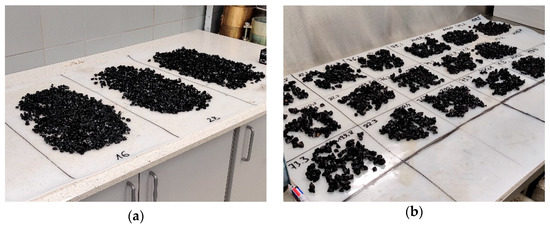
Figure 1.
Sample preparation process: (a) coated aggregates left for cooling; (b) samples after the boiling water stripping test.
Three 200 g ± 0.5 g samples were prepared for boiling tests from each of the coated aggregate batches. The boiling water stripping tests were conducted in line with EN 12697-11. After the boiling tests, samples were transferred onto silicone rubber mats. The aggregate particles were separated and left for cooling and drying for a time period of a minimum of 24 h (Figure 1b).
2.3.2. Digital Image Capture and Analysis
Based on previous trials and the experiences of other researchers [51,52,53,54,55,56,57], a methodology for acquiring high-quality photographic data was developed, main principles of which included:
- Image acquisition under repeatable, controlled, artificial lighting using a ring light;
- Use of a distinct background color for ease of its removal in post-processing, should it be necessary;
- Placing the sample aggregates without gaps for mitigating the background reflections;
- Each sample was photographed once, then it was flipped, and its underside was photographed again to obtain more data per sample; this also would decrease any potential bias of the initial sample arrangement.
The capture of digital images of the aggregate samples was carried out using a consumer photographic mirrorless camera with an APS-C CMOS III sensor (Fujifilm, Tokio, Japan). The camera was placed on a tripod, looking straight down on the photographed sample (Figure 2a). The optics were set at a focal length of 55 mm and f/11 aperture to mitigate distortions and provide adequate depth of field. Directly to the lens, two accessories were attached: a circular polarizing filter (for controlling reflections on the bitumen surface) and a ring light (primary light source). The exposure settings were set to omit clipping of highlights and shadows, and a reference target was used to equalize all exposures in post-processing.
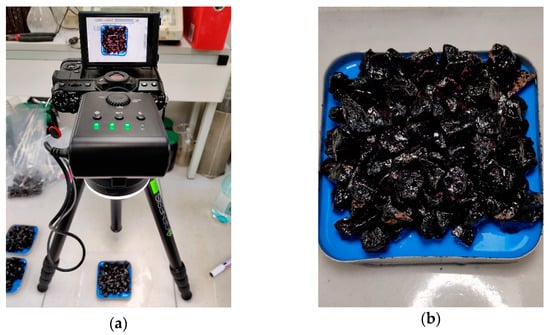
Figure 2.
Acquisition of digital images: (a) setup used for the digital imaging; (b) sample prepared for digital imaging.
The aggregate samples, which were previously subjected to the boiling water stripping tests, were carefully arranged on small trays filled with silicone rubber in a total of 2 to 3 layers, ensuring that the background (silicone rubber) would not reflect off the asphalt binder coating the aggregates (Figure 2b). The samples were photographed once, and after they were flipped, the arrangement of the particles was corrected so that a second photograph could be taken. The samples were packaged and archived.
Before the actual analysis was performed, the images were subjected to preprocessing to equalize the exposure characteristics and cropped to view only the central part of the sample. The images were analyzed using a Python [69] script and the OpenCV package [70]. The original RGB (red, green, blue) images were analyzed using the HSV (hue, saturation, value) color model used widely in computer vision and image analysis [71,72]. Using this method, the image areas corresponding to the background, aggregates covered with asphalt binder, and to stripped aggregate surface were identified and verified using color masks (Figure 3). Based on these masks, the pixel counts were obtained for those regions. The areas calculated from two pictures, taken before and after sample flipping (Figure 3a,b), were added, and asphalt binder coverage of the visible aggregate surface was calculated.
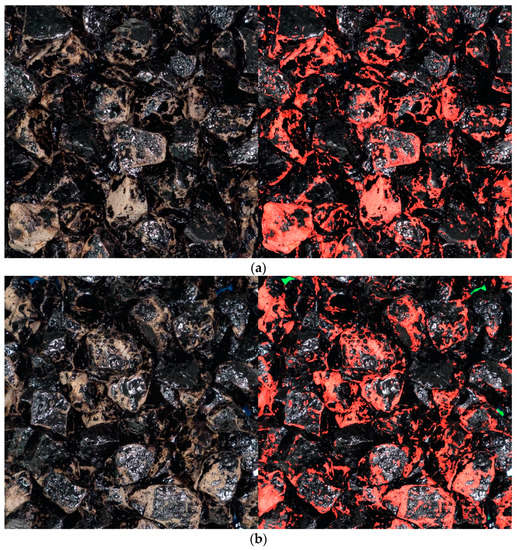
Figure 3.
Exemplary results of PMB-B-N-H-Q experiment image analysis: (a) first photograph—78.7% coverage; (b) second photograph after sample flipping and rearranging of aggregate particles—79.3% coverage; final sample coverage—79.0%.
2.3.3. Conventional Testing of Bituminous Binders
Dynamic viscosity (EN 13302) was measured using a DHR-2 dynamic shear rheometer (Discovery Hybrid Rheometer, 2019, TA Instruments, New Castle, DE, USA) in rotating spindle (coaxial cylinders) configuration as shown in Figure 4a, with three replicates. While testing the foamed binders, the DSR had to be protected from spontaneous bursts of the foamed bitumen, which were found to be occurring at temperatures exceeding 130 °C due to a very small testing geometry gap (Figure 4b). This phenomenon also inhibited the testing of foamed binders at temperatures in excess of 145 °C. The dynamic viscosity measurements were conducted at a 1/s shear rate from the highest to the lowest temperature.
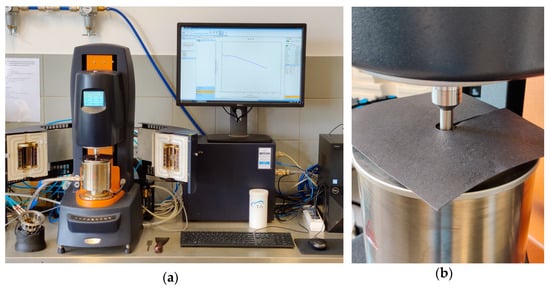
Figure 4.
TA Instruments DHR-2 rheometer: (a) the device; (b) a protecting cover in case of spontaneous bursts of foamed bitumen.
2.3.4. Fourier-Transform Infrared Spectrometric Analysis
In this study, attenuated total reflectance Fourier-transform infrared (ATR-FTIR) spectroscopy was used to evaluate the composition of the foamed binders. The Thermo-Scientific Nicolet iS 5 FTIR Spectrometer (Waltham, MA, USA) and the PIKE Technologies GladiATR (Madison, WI, USA) attenuated total reflectance accessory with a diamond window was used. The bitumen samples after foaming were poured into 1 dm3 glass containers, reheated at 140 °C for 2 h, and homogenized for uniform distribution of water during the first stages of cooling at room temperature. The testing was conducted 3 days after foaming. Samples were transferred onto the ATR crystal mechanically, without reheating. Three different samples of each binder were tested, and the potential effects of foaming on the binders’ chemical composition, specifically due to oxidative aging, were measured by evaluating the formation of sulfoxide and carbonyl compounds [73]. Additionally, the presence of elastomeric additives was investigated in their specific absorption bands.
The quantitative evaluation of the mentioned compounds was conducted by calculating normalized indices as given in Table 4. The areas under the respective peaks were computed by the common tangent baseline method as proposed in the work of [74].

Table 4.
Structural indices calculated for the bituminous binders [75,76,77,78,79,80].
3. Results
The results are shown in the form of bar plots, with the bars representing the means of the measured values and the width of whiskers (‘error bars’) corresponding to the width of 95% confidence intervals. The values printed on the figures also refer to the mean measured values and 95% CI’s.
3.1. Properties of the Asphalt Binders
The results of dynamic viscosity tests are presented in Figure 5 and Figure 6. The presented values were measured at different temperatures corresponding to the temperatures used in the preparation and execution of the boiling water stripping tests: 100 °C corresponding to the boiling tests, 130 and 150 °C as when mixing of the paving-grade bitumen with aggregates, 145 and 165 °C as when mixing of the polymer-modified bitumen with aggregates. In principle, higher values of dynamic viscosity at the temperature of the boiling test and lower values at the mixing temperature should improve the stripping performance.
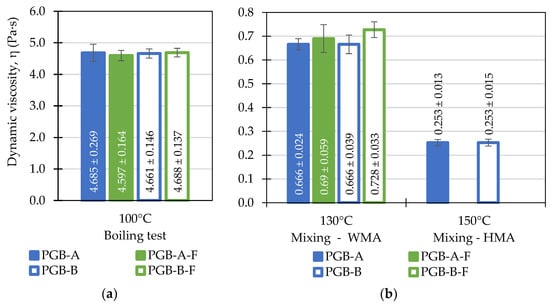
Figure 5.
Results of the dynamic viscosity testing of the investigated paving-grade bitumen (PGB) before and after foaming (F) evaluated at: (a) 100 °C—the temperature of the boiling water stripping tests; (b) 130 and 150 °C—the aggregate-binder mixing temperatures.

Figure 6.
Results of the dynamic viscosity testing of the investigated polymer-modified bitumen (PMB) before and after foaming (F) evaluated at: (a) 100 °C—the temperature of the boiling water stripping tests; (b) 145 °C and 165 °C—the aggregate-binder mixing temperatures.
As it can be seen in Figure 5, the paving-grade bitumen binders obtained from two different suppliers presented similar viscosity characteristics in the investigated temperature range. As shown in Table 2, the binders were also very similar in terms of penetration and softening point. The non-foamed binders exhibited nearly identical values of dynamic viscosity. It was also observed that foaming had little influence on this property of both asphalt binders. The mean values of dynamic viscosity of the foamed binders were slightly higher than in the case of the non-foamed bitumen, but the variance in the data was too large (specifically at 130 °C) to permit any strict conclusions in this regard. It was observed after the testing that both foamed paving-grade binders presented little foaming potential.
Figure 6 presents the results of dynamic viscosity testing of the polymer-modified bitumen binders sourced from the two refineries. In this case, the differences in dynamic viscosities of these binders were more pronounced, with the PMB-B binder exhibiting higher η values. What is more, the process of foaming had different effects in this case. Both polymer-modified binders exhibited significant drops in dynamic viscosity after foaming at the temperature of the boiling stripping test (100 °C). At higher testing temperatures, this effect was less visible.
Figure 7 presents the values of the structural indices based on the measurements of ATR-FTIR spectra of the investigated paving-grade and polymer-modified binders sourced from both refineries.
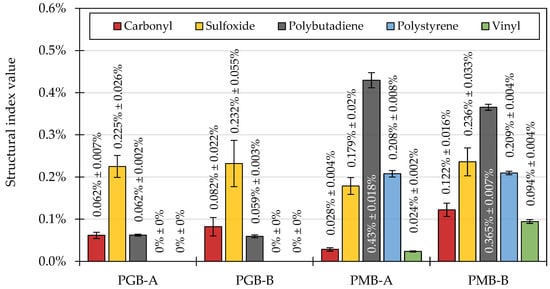
Figure 7.
Values of the structural indices calculated based on the ATR-FTIR spectra of the investigated binders.
The two paving-grade bitumen binders showed similar chemical characteristics, which correlates with their performance in penetration, softening point, and dynamic viscosity tests. Both PGB binders showed similar values of the carbonyl and sulfoxide indices. The peaks in the carbonyl region were mostly found in the 1660–1715 cm−1 region (Figure 8a), characteristic of ketone compounds [73,81,82].
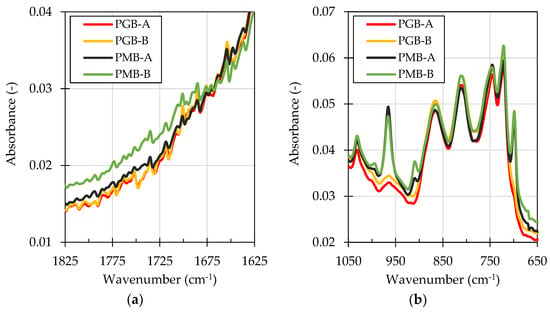
Figure 8.
Infrared (ATR-FTIR) absorbance spectra of the evaluated binders in the 1625–1825 cm−1 (a) and the 650–1050 cm−1 (b) wavenumber ranges.
The PMB-A and PMB-B binders were more different in their chemical characterization. Higher concentrations of carbonyl and sulfoxide compounds were found to be present in the PMB-B binder. The ratios of the calculated polybutadiene, polystyrene, and vinyl indices also were different in the two PMBs, probably as a result of different polymers being used for their modification (Figure 8b).
3.2. Results of the Boiling Water Stripping Tests
Figure 9 presents exemplary results of the image analysis conducted on binder-coated aggregate samples after the boiling water stripping tests. The figure presents different samples of limestone and quartzite aggregates characterized by a range of approximately 34% to 91% binder coverage, in increasing order.
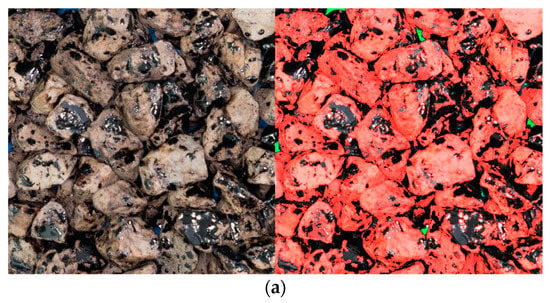
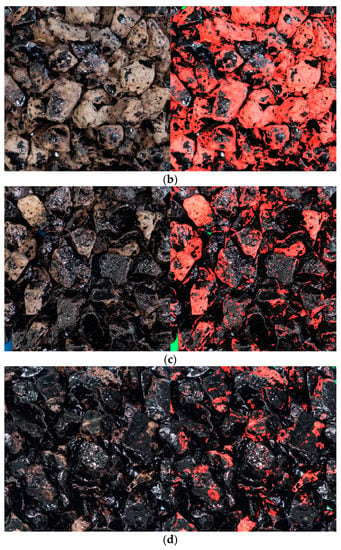
Figure 9.
Exemplary results of the image analysis: (a) PGB-A-N-W-Q sample—34% coverage; (b) PGB-A-F-W-Q sample—47.6% coverage; (c) PMB-A-N-H-Q sample—79.9% coverage; (d) PGB-B-F-W-L sample—90.8% coverage.
The results of the conducted boiling water stripping tests are presented in Figure 10 in the form of boxplots with individual test values shown as dots and 95% confidence intervals (whiskers).

Figure 10.
Results of boiling water stripping tests: (a) limestone aggregate; (b) quartzite aggregate.
The residual asphalt binder coverage was significantly affected by all the evaluated factors: type of the binder, source of the binder, form of the binder, temperature of mixing, and above all, the type of the aggregate. The variability of the results was significantly influenced by the aggregate. When limestone aggregate was used, the values of residual asphalt binder coverage ranged from 87.95% ± 3.73% to 99.00% ± 0.20%, whereas in the case of quartzite aggregate, these values ranged from 39.33% ± 6.68% to 86.77% ± 3.03%. This shows that the limestone aggregate enabled very strong bonding with the bitumen binders in all of the investigated cases. On the other hand, the aggregate-bitumen systems with quartzite aggregate were significantly more susceptible to the changing parameters of the coating process. When quartzite aggregates were used, the effects of binder type, its source, its form, and coating temperature could be clearly observed. The asphalt binders from source ‘A’ returned lower values of residual asphalt binder coverage. In addition, lowering the mixing temperatures resulted in a decrease in the coverage values. It was found that this effect could be partially mitigated by the use of the binder in the form of foam, as the experiments with foamed binders yielded higher values of residual asphalt binder coverage compared to the typical liquid binder. It can also be concluded that polymer-modified binders provided better resistance to the displacing action of water.
When evaluating the effects of asphalt binder foaming and the mixing temperatures, in many cases, it can be seen that the experiments involving foamed asphalt binder and WMA temperatures resulted in residual asphalt binder coverage comparable to those obtained in experiments representing typical hot mixtures (non-foamed binder, higher mixing temperatures). The use of water foaming in many of those instances (usually when asphalt binder from source B was used) compensated for the decreased coating temperatures.
4. Discussion
The conducted boiling water stripping tests permitted the evaluation of the investigated factors on the asphalt binder-aggregate bonding, specifically in the case of quartzite aggregates. Clear differences could be observed in the performance of the asphalt binders based on their source. Both types of the binders obtained from source B, the paving-grade bitumen and polymer-modified bitumen, provided stronger adhesion to the aggregates. This was most strongly visible in the case of the quartzite aggregate, but this statement is also true for limestone aggregates. The results of the rheological tests and chemical analysis provided little explanation for this outcome.
The biggest differences in the residual asphalt binder coverage were seen in the PGB binders, which differed the least in the values of dynamic viscosity across all evaluated temperatures. On the other hand, the stripping performance of the polymer-modified binders was more similar; however, their dynamic viscosities differed greatly.
The results of the chemical analysis were also inconclusive in terms of discriminating the performance of the binders from the two sources. According to some authors [58,59], the carbonyl-band compounds and sulfoxides present in the bitumen are among the most strongly adsorbed on the aggregate surfaces. It is most often reported that carboxylic acids and sulfoxides are most easily displaced by water, while ketones have the least propensity to be displaced by water among the strongly adsorbed compounds. Although these functional groups were identified in the evaluated asphalt binders, their concentrations were low, typical of neat binders [37]. Additionally, the carbonyl indices of the evaluated binders were mainly shaped by the absorption bands of ketones (Figure 8a). In other studies, it was also reported [83] that even asphalt binders known to contain ketones and sulfoxides (RTFO-PAV aged) may perform well in terms of resistance to water action. It is also known that among the most significant factors influencing the moisture resistance of asphalt binders in binder-aggregate systems, other than the aggregate type, is the nitrogen content in the binder [58] and use of caustics during asphalt binder production [58,66], which were not evaluated in this study.
5. Conclusions
The present paper provided novel findings regarding the impacts of water foaming on the phenomena of asphalt binder-aggregate adhesion in a model study including boiling water stripping tests. The study evaluated additional factors, including the type of the binder, its source, mixing temperature, and type of the aggregate based on its affinity to bituminous binders.
The presented results showed that the mechanical water foaming of the bitumen improved its resistance to the displacing action of water, regardless of the source, type, and chemical characteristics of the binder. These observations were confirmed in limestone and quartzite aggregates, with hot-mix and warm-mix mixing temperatures used. The experiments have also shown that the decreased mixing temperature had visibly detrimental effects on the adhesive bond between the aggregates and asphalt binder, specifically in the case of quartzite aggregates.
The tests have also shown that the performance of the investigated bituminous binders was highly dependent on their source (producer), despite vary similar basic, chemical (based on FTIR analysis), and dynamic viscosity characteristics.
The findings of this study may put in new perspective several prior experimental works regarding the moisture susceptibility of warm-mix asphalts produced with foamed bitumen.
A number of technical observations were made based on the present research, previous trials, and the experiences of other researchers [51,52,53,54,55,56,57]:
- Repeatable lighting conditions with uniform lighting and mitigation of shadows are recommended;
- Careful selection and preparation of the workplace is required to mitigate color contaminated light reflections (e.g., blue color from the sky, other colors from clothes, furniture, etc.);
- Precise arrangement of the aggregate particles without visible gaps is highly recommended for reliable classification of the reflective surfaces of asphalt binder; when gaps are present, the background reflects off the asphalt binder, which makes it difficult to distinguish from the binder, regardless of the background color;
- When artificial lighting is used and color analysis is made, use of lighting with high color reproduction index (CRI) is advised.
Funding
This research was supported by the National Science Centre of Poland, grant number 2020/04/X/ST8/00665. The APC was funded by the program of the Minister of Science and Higher Education under the name: Regional Initiative of Excellence in 2019–2022 project number 025/RID/2018/19, financing amount PLN 12.000.000.
Institutional Review Board Statement
Not applicable.
Informed Consent Statement
Not applicable.
Data Availability Statement
Data available on request.
Acknowledgments
This research was conducted as a part of Miniatura 4 ‘Badania nad wpływem spienienia lepiszcza asfaltowego i obniżenia temperatury otaczania kruszyw mineralnych na zjawisko adhezji lepiszcza do kruszywa’ (Investigation of asphalt binder foaming and decrease in coating temperature on the adhesion in asphalt binder-aggregate systems) project funded by the National Science Centre of Poland, grant number 2020/04/X/ST8/00665.
Conflicts of Interest
The author declares no conflict of interest.
References
- Remišová, E.; Decký, M.; Mikolaš, M.; Hájek, M.; Kovalčík, L.; Mečár, M. Design of Road Pavement Using Recycled Aggregate. IOP Conf. Ser. Earth Environ. Sci. 2016, 44, 022016. [Google Scholar] [CrossRef]
- Bańkowski, W.; Krol, J.; Gałązka, K.; Liphardt, A.; Horodecka, R. Design and verification of bituminous mixtures with the increased content of reclaimed asphalt pavement. IOP Conf. Ser. Mater. Sci. Eng. 2018, 356, 012009. [Google Scholar] [CrossRef]
- Ma, Y.; Polaczyk, P.; Park, H.; Jiang, X.; Hu, W.; Huang, B. Performance evaluation of temperature effect on hot in-place recycling asphalt mixtures. J. Clean. Prod. 2020, 277, 124093. [Google Scholar] [CrossRef]
- Raschia, S.; Moghaddam, T.B.; Perraton, D.; Baaj, H.; Carter, A.; Graziani, A. Effect of RAP Source on Compactability and Behavior of Cold-Recycled Mixtures in the Small Strain Domain. J. Mater. Civ. Eng. 2021, 33, 04021030. [Google Scholar] [CrossRef]
- Skotnicki, Ł.; Kuźniewski, J.; Szydło, A. Research on the Properties of Mineral–Cement Emulsion Mixtures Using Recycled Road Pavement Materials. Materials 2021, 14, 563. [Google Scholar] [CrossRef] [PubMed]
- Ma, Y.; Hu, W.; Polaczyk, P.; Han, B.; Xiao, R.; Zhang, M.; Huang, B. Rheological and aging characteristics of the recycled asphalt binders with different rejuvenator incorporation methods. J. Clean. Prod. 2020, 262, 121249. [Google Scholar] [CrossRef]
- Jurczak, R.; Mieczkowski, P.; Budziński, B. Potential of Using Imidazoline in Recycled Asphalt Pavement. Balt. J. Road Bridg. Eng. 2019, 14, 521–542. [Google Scholar] [CrossRef]
- Czapik, P.; Zapała-Sławeta, J.; Owsiak, Z.; Stępień, P. Hydration of cement by-pass dust. Constr. Build. Mater. 2019, 231, 117139. [Google Scholar] [CrossRef]
- Owsiak, Z.; Czapik, P.; Zapała-Sławeta, J. Properties of a Three-Component Mineral Road Binder for Deep-Cold Recycling Technology. Materials 2020, 13, 3585. [Google Scholar] [CrossRef]
- Chomicz-Kowalska, A.; Iwański, M.M.; Mrugała, J. Basic Performance of Fibre Reinforced Asphalt Concrete with Reclaimed Asphalt Pavement Produced In Low Temperatures with Foamed Bitumen. IOP Conf. Ser. Mater. Sci. Eng. 2017, 245, 032092. [Google Scholar] [CrossRef]
- Chomicz-Kowalska, A. Laboratory testing of low temperature asphalt concrete produced in foamed bitumen technology with fiber reinforcement. Bull. Pol. Acad. Sci. Tech. Sci. 2017, 65, 779–790. [Google Scholar] [CrossRef]
- Radziszewski, P.; Sarnowski, M.; Plewa, A.; Pokorski, P. Properties of Asphalt Concrete with Basalt-Polymer Fibers. Arch. Civ. Eng. 2018, 64, 197–209. [Google Scholar] [CrossRef]
- Abtahi, S.M.; Sheikhzadeh, M.; Hejazi, S.M. Fiber-reinforced asphalt-concrete—A review. Constr. Build. Mater. 2010, 24, 871–877. [Google Scholar] [CrossRef]
- D’Angelo, J.A.; Harm, E.E.; Bartoszek, J.C.; Baumgardner, G.L. Warm-Mix Asphalt: European Practice; Federal Highway Administration: Washington, DC, USA, 2008.
- Iwanski, M.; Chomicz-Kowalska, A. Moisture and Frost Resistance of the Recycled Base Rehabilitated with the Foamed Bitumen Technology/Odpornosc Na Oddziaływanie Wody I Mrozu Podbudowy W Technologii Recyklingu Z Asfaltem Spienionym. Arch. Civ. Eng. 2012, 58, 185–198. [Google Scholar] [CrossRef][Green Version]
- Behnood, A. A review of the warm mix asphalt (WMA) technologies: Effects on thermo-mechanical and rheological properties. J. Clean. Prod. 2020, 259, 120817. [Google Scholar] [CrossRef]
- Polaczyk, P.; Ma, Y.; Xiao, R.; Hu, W.; Jiang, X.; Huang, B. Characterization of aggregate interlocking in hot mix asphalt by mechanistic performance tests. Road Mater. Pavement Des. 2021, 22, S498–S513. [Google Scholar] [CrossRef]
- Rizvi, M.A.; Khan, A.H.; Rehman, Z.U.; Inam, A.; Masoud, Z. Evaluation of Linear Deformation and Unloading Stiffness Characteristics of Asphalt Mixtures Incorporating Various Aggregate Gradations. Sustainability 2021, 13, 8865. [Google Scholar] [CrossRef]
- Renken, P.; Büchler, S.; Falchetto, A.C.; Wang, D.; Wistuba, M.P. Warm Mix Asphalt—A German Case Study. Asph. Paving Technol. 2018, 87, 685–716. [Google Scholar] [CrossRef]
- Prowell, B.D.; Hurley, G.C. Warm-Mix Asphalt: Best Practices, 3rd ed.; National Asphalt Paving Association: Lanham, MD, USA, 2012. [Google Scholar]
- Ali, A.; Abbas, A.; Nazzal, M.; Alhasan, A.; Roy, A.; Powers, D. Effect of temperature reduction, foaming water content, and aggregate moisture content on performance of foamed warm mix asphalt. Constr. Build. Mater. 2013, 48, 1058–1066. [Google Scholar] [CrossRef]
- Remišová, E.; Holý, M. Changes of Properties of Bitumen Binders by Additives Application. IOP Conf. Ser. Mater. Sci. Eng. 2017, 245, 032003. [Google Scholar] [CrossRef]
- Iwański, M.M.; Chomicz-Kowalska, A.; Maciejewski, K. Resistance to Moisture-Induced Damage of Half-Warm-Mix Asphalt Concrete with Foamed Bitumen. Materials 2020, 13, 654. [Google Scholar] [CrossRef] [PubMed]
- Iwański, M.; Chomicz-Kowalska, A.; Mazurek, G.; Buczyński, P.; Cholewińska, M.; Iwański, M.; Maciejewski, K.; Ramiączek, P. Effects of the Water-Based Foaming Process on the Basic and Rheological Properties of Bitumen 70/100. Materials 2021, 14, 2803. [Google Scholar] [CrossRef] [PubMed]
- Woszuk, A.; Zofka, A.; Bandura, L.; Franus, W. Effect of zeolite properties on asphalt foaming. Constr. Build. Mater. 2017, 139, 247–255. [Google Scholar] [CrossRef]
- Chomicz-Kowalska, A.; Maciejewski, K.; Iwański, M.M.; Janus, K. Effects of zeolites and hydrated lime on volumetrics and moisture resistance of foamed warm mix asphalt concrete. Bull. Polish Acad. Sci. Tech. Sci. 2021, e136731. [Google Scholar] [CrossRef]
- Ghabchi, R.; Singh, D.; Zaman, M. Laboratory evaluation of stiffness, low-temperature cracking, rutting, moisture damage, and fatigue performance of WMA mixes. Road Mater. Pavement Des. 2014, 16, 334–357. [Google Scholar] [CrossRef]
- Chomicz-Kowalska, A.; Maciejewski, K. Performance and viscoelastic assessment of high-recycle rate cold foamed bitumen mixtures produced with different penetration binders for rehabilitation of deteriorated pavements. J. Clean. Prod. 2020, 258, 120517. [Google Scholar] [CrossRef]
- Pucułek, M.; Liphardt, A.; Radziszewski, P. Evaluation of the possibility of reduction of highly modified binders technological temperatures. Arch. Civ. Eng. 2020, 67, 557–570. [Google Scholar] [CrossRef]
- Rubio, M.C.; Martínez, G.; Baena, L.; Moreno, F. Warm mix asphalt: An overview. J. Clean. Prod. 2012, 24, 76–84. [Google Scholar] [CrossRef]
- Iwański, M.M. Synergistic Effect of F–T Synthetic Wax and Surface-Active Agent Content on the Properties and Foaming Characteristics of Bitumen 50/70. Materials 2021, 14, 300. [Google Scholar] [CrossRef]
- Chomicz-Kowalska, A.; Maciejewski, K.; Iwański, M.M. Study of the Simultaneous Utilization of Mechanical Water Foaming and Zeolites and Their Effects on the Properties of Warm Mix Asphalt Concrete. Materials 2020, 13, 357. [Google Scholar] [CrossRef]
- Bairgi, B.K.; Tarefder, R.A. Effect of Foaming Water Contents on High-Temperature Rheological Characteristics of Foamed Asphalt Binder. In Proceedings of the International Conference on Transportation and Development 2018, Pittsburgh, PA, USA, 15–18 July 2021; pp. 243–251. [Google Scholar]
- Bairgi, B.K.; Mannan, U.A.; Tarefder, R.A. Influence of foaming on tribological and rheological characteristics of foamed asphalt. Constr. Build. Mater. 2019, 205, 186–195. [Google Scholar] [CrossRef]
- Bairgi, B.K.; Mannan, U.A.; Tarefder, R.A. Tribological Evaluation for an In-Depth Understanding of Improved Workability of Foamed Asphalt. Transp. Res. Rec. J. Transp. Res. Board 2019, 2673, 533–545. [Google Scholar] [CrossRef]
- Maciejewski, K. High Temperature Properties of Paving Grade Bitumens for Foamed Warm-Mix Asphalt in Terms of the Used Additives and Laboratory Short-Term Aging. Ph.D. Thesis, Kielce University of Technology, Kielce, Poland, 2019. [Google Scholar]
- Maciejewski, K.; Chomicz-Kowalska, A. Foaming Performance and FTIR Spectrometric Analysis of Foamed Bituminous Binders Intended for Surface Courses. Materials 2021, 14, 2055. [Google Scholar] [CrossRef] [PubMed]
- Sunarjono, S. The Influence of Foamed Bitumen Characteristics on Cold-Mix Asphalt Properties. Ph.D. Thesis, University of Nottingham, Nottingham, UK, 2008. [Google Scholar]
- Huang, B.; Zhang, Y.; Shu, X.; Liu, Y.; Penumadu, D.; Ye, X.P. Neutron Scattering for Moisture Detection in Foamed Asphalt. J. Mater. Civ. Eng. 2013, 25, 932–938. [Google Scholar] [CrossRef]
- Martinez-Arguelles, G.; Giustozzi, F.; Crispino, M.; Flintsch, G.W. Investigating physical and rheological properties of foamed bitumen. Constr. Build. Mater. 2014, 72, 423–433. [Google Scholar] [CrossRef]
- Yu, X.; Wang, Y.; Luo, Y. Impacts of water content on rheological properties and performance-related behaviors of foamed warm-mix asphalt. Constr. Build. Mater. 2013, 48, 203–209. [Google Scholar] [CrossRef]
- Iwański, M.; Mazurek, G.; Buczyński, P.; Zapała-Sławeta, J. Multidimensional analysis of foaming process impact on 50/70 bitumen ageing. Constr. Build. Mater. 2020, 266, 121231. [Google Scholar] [CrossRef]
- Rahman, M.A.; Ghabchi, R.; Zaman, M.; Ali, S.A. Rutting and moisture-induced damage potential of foamed warm mix asphalt (WMA) containing RAP. Innov. Infrastruct. Solut. 2021, 6, 1–11. [Google Scholar] [CrossRef]
- Shu, X.; Huang, B.; Shrum, E.D.; Jia, X. Laboratory evaluation of moisture susceptibility of foamed warm mix asphalt containing high percentages of RAP. Constr. Build. Mater. 2012, 35, 125–130. [Google Scholar] [CrossRef]
- Bairgi, B.K.; Hasan, A.; Tarefder, R.A. Effects of Asphalt Foaming on Damage Characteristics of Foamed Warm Mix Asphalt. Transp. Res. Rec. J. Transp. Res. Board 2021, 2675, 318–331. [Google Scholar] [CrossRef]
- Cucalon, L.G.; Martin, A.; Arambula, E.; Yin, F.; Estakhri, C.; Park, E.; Epps, J. Moisture susceptibility of Warm-Mix Asphalt. Asph. Pavements 2014, 691–700. [Google Scholar] [CrossRef]
- Xu, S.; Xiao, F.; Amirkhanian, S.; Singh, D. Moisture characteristics of mixtures with warm mix asphalt technologies—A review. Constr. Build. Mater. 2017, 142, 148–161. [Google Scholar] [CrossRef]
- Cucalon, L.G.; Kassem, E.; Little, D.N.; Masad, E. Fundamental evaluation of moisture damage in warm-mix asphalts. Road Mater. Pavement Des. 2016, 18, 258–283. [Google Scholar] [CrossRef]
- Paliukaitė, M.; Vorobjovas, V.; Bulevičius, M.; Andrejevas, V. Evaluation of Different Test Methods for Bitumen Adhesion Properties. Transp. Res. Procedia 2016, 14, 724–731. [Google Scholar] [CrossRef]
- Renken, P.; Wistuba, M.P.; Groeninger, J.; Schindler, K. Adhaesion von Bitumen am Gestein: Verfahren der quantitativen Bestimmung auf Grundlage der Europaeischen Normung. Forsch. Straßenbau Straßenverkehrstechnik 2011, 1043. [Google Scholar]
- Mei, A.; Fusco, R.; Moroni, M.; Fiore, N.; Fontinovo, G.; D’Andrea, A. Affinity between Bitumen and Aggregate in Hot Mix Asphalt by Hyperspectral Imaging and Digital Picture Analysis. Coatings 2021, 11, 648. [Google Scholar] [CrossRef]
- Komačka, J.; Budjačová, E.; Remišová, E. Colour-histogram-based assessment procedure of the rolling bottle test considering the drawbacks in the digital image analysis of bitumen–aggregate systems. Mater. Struct. 2019, 52, 59. [Google Scholar] [CrossRef]
- Grönniger, J.; Wistuba, M.P.; Renken, P. Adhesion in Bitumen-Aggregate-Systems. Road Mater. Pavement Des. 2010, 11, 881–898. [Google Scholar] [CrossRef]
- Júnior, J.L.L.; Babadopulos, L.F.; Soares, J.B. Moisture-induced damage resistance, stiffness and fatigue life of asphalt mixtures with different aggregate-binder adhesion properties. Constr. Build. Mater. 2019, 216, 166–175. [Google Scholar] [CrossRef]
- Lantieri, C.; Lamperti, R.; Simone, A.; Vignali, V.; Sangiorgi, C.; Dondi, G.; Magnani, M. Use of image analysis for the evaluation of rolling bottle tests results. Int. J. Pavement Res. Technol. 2017, 10, 45–53. [Google Scholar] [CrossRef]
- Källén, H.; Heyden, A.; Åström, K.; Lindh, P. Measuring and evaluating bitumen coverage of stones using two different digital image analysis methods. Measurement 2016, 84, 56–67. [Google Scholar] [CrossRef]
- Cui, P.; Wu, S.; Xiao, Y.; Wang, F.; Wang, F. Quantitative evaluation of active based adhesion in Aggregate-Asphalt by digital image analysis. J. Adhes. Sci. Technol. 2019, 33, 1544–1557. [Google Scholar] [CrossRef]
- Petersen, J.C.; Plancher, H. Model studies and interpretive review of the competitive adsorption and water displacement of petroleum asphalt chemical functionalities on mineral aggregate surfaces. Pet. Sci. Technol. 1998, 16, 89–131. [Google Scholar] [CrossRef]
- Plancher, H.; Dorrence, S.M.; Petersen, J.C. Identification of chemical types in asphalts strongly adsorbed at the asphalt-aggregate interface and their relative displacement by water. [Moisture damage to roads]. In Proceedings of the Annual Meeting of the Association of Asphalt Paving Technologists, San Antonio, TX, USA, 21 February 1977. [Google Scholar]
- Hicks, R.G. Moisture Damage in Asphalt Concrete; Transportation Research Board: Washington, DC, USA, 1991; p. 175. [Google Scholar]
- European Committee for Standardization. EN 12697-35: Bituminous Mixtures. Test Methods-Laboratory Mixing; Comité Européen de Normalisation (CEN): Brussels, Belgium, 2016. [Google Scholar]
- European Committee for Standardization. EN 12591: Bitumen and Bituminous Binders-Specifications for Paving Grade Bitumens; Comité Européen de Normalisation (CEN): Brussels, Belgium, 2009. [Google Scholar]
- European Committee for Standardization. EN 14023: Bitumen and Bituminous Binders-Specification Framework for Polymer Modified Bitumens; Comité Européen de Normalisation (CEN): Brussels, Belgium, 2010. [Google Scholar]
- European Committee for Standardization. EN 1426: Bitumen and Bituminous Binders-Determination of Needle Penetration; Comité Européen de Normalisation (CEN): Brussels, Belgium, 2015. [Google Scholar]
- European Committee for Standardization. EN 1427: Bitumen and Bituminous Binders-Determination of the Softening Point-Ring and Ball Method; Comité Européen de Normalisation (CEN): Brussels, Belgium, 2015. [Google Scholar]
- European Committee for Standardization. EN 12593: Bitumen and Bituminous Binders-Determination of the Fraass Breaking Point; Comité Européen de Normalisation (CEN): Brussels, Belgium, 2015. [Google Scholar]
- European Committee for Standardization. EN 13043: Aggregates for Bituminous Mixtures and Surface Treatments for Roads, Airfields and Other Trafficked Areas; Comité Européen de Normalisation (CEN): Brussels, Belgium, 2013. [Google Scholar]
- European Committee for Standardization. EN 12697-11: Bituminous Mixtures. Test Methods-Determination of the Affinity between Aggregate and Bitumen; Comité Européen de Normalisation (CEN): Brussels, Belgium, 2020. [Google Scholar]
- Python. Available online: https://www.python.org/ (accessed on 31 October 2020).
- Open CV. Available online: https://pypi.org/project/opencv-python/ (accessed on 10 July 2021).
- Noor, A.I.; Mokhtar, M.H.; Rafiqul, Z.K.; Pramod, K.M. Understanding Color Models: A Review. ARPN J. Sci. Technol. 2012, 2, 265–275. [Google Scholar]
- Phuangsaijai, N.; Jakmunee, J.; Kittiwachana, S. Investigation into the predictive performance of colorimetric sensor strips using RGB, CMYK, HSV, and CIELAB coupled with various data preprocessing methods: A case study on an analysis of water quality parameters. J. Anal. Sci. Technol. 2021, 12, 1–16. [Google Scholar] [CrossRef]
- Technical Activities Division. Transportation Research Board A Review of the Fundamentals of Asphalt Oxidation: Chemical, Physicochemical, Physical Property, and Durability Relationships. Transp. Res. Circ. 2009. [Google Scholar] [CrossRef]
- Schrader, B. (Ed.) Infrared and Raman Spectroscopy: Methods and Applications; John Wiley & Sons: Hoboken, NJ, USA, 1995; Volume 380, ISBN 3-527-26446-9. [Google Scholar]
- Curtis, C.W.; Hanson, D.I.; Chen, S.T.; Shieh, G.J.; Ling, M. Quantitative determination of polymers in asphalt cements and hot-mix asphalt mixes. Transp. Res. Rec. 1995, 1488, 52–61. [Google Scholar]
- Lamontagne, J. Comparison by Fourier transform infrared (FTIR) spectroscopy of different ageing techniques: Application to road bitumens. Fuel 2001, 80, 483–488. [Google Scholar] [CrossRef]
- Masson, J.F.; Pelletier, L.; Collins, P. Rapid FTIR method for quantification of styrene-butadiene type copolymers in bitumen. J. Appl. Polym. Sci. 2001, 79, 1034–1041. [Google Scholar] [CrossRef]
- Nasrazadani, S.; Mielke, D.; Springfield, T.; Ramasamy, N. Practical Applications of FTIR to Characterize Paving Materials; Technical Report 0-5608-1; University of North Texas: Denton, TX, 2010. [Google Scholar]
- Fernández-Berridi, M.J.; González, N.; Mugica, A.; Bernicot, C. Pyrolysis-FTIR and TGA techniques as tools in the characterization of blends of natural rubber and SBR. Thermochim. Acta 2006, 444, 65–70. [Google Scholar] [CrossRef]
- Yut, I.; Zofka, A. Correlation between rheology and chemical composition of aged polymer-modified asphalts. Constr. Build. Mater. 2014, 62, 109–117. [Google Scholar] [CrossRef]
- Silverstein, R.M.; Webster, F.; Kiemle, D.J. Spectrometric Identification of Organic Compounds; John Wiley & Sons: New York, NY, USA, 2005; ISBN 978-0-470-61637-6. [Google Scholar]
- Zofka, A.; Maliszewska, D.; Maliszewski, M. Application of FTIR ATR method to examine the polymer content in the modified bitumen and to assess susceptibility of bitumen to ageing. Roads Bridges-Drogi i Mosty 2015, 14, 163–174. [Google Scholar] [CrossRef]
- Huang, S.-C. The influence of aggregate on moisture susceptibility in terms of asphalt-aggregate interactions. In Proceedings of the Sixth International RILEM Symposium on Performance Testing and Evaluation of Bituminous Materials, Zurich, Switzerland, 14–16 April 2003; RILEM Publications SARL: Bagneaux, France, 2003; pp. 177–183. [Google Scholar]
Publisher’s Note: MDPI stays neutral with regard to jurisdictional claims in published maps and institutional affiliations. |
© 2021 by the author. Licensee MDPI, Basel, Switzerland. This article is an open access article distributed under the terms and conditions of the Creative Commons Attribution (CC BY) license (https://creativecommons.org/licenses/by/4.0/).